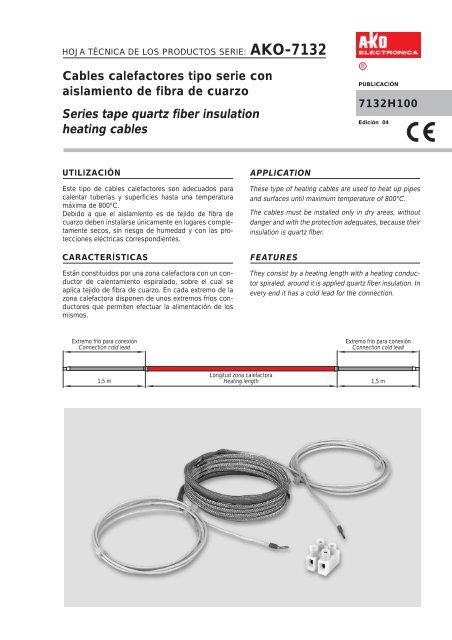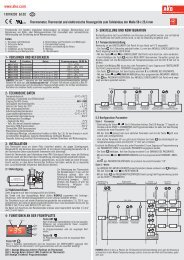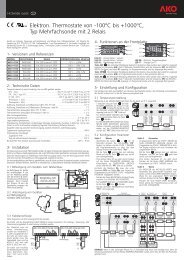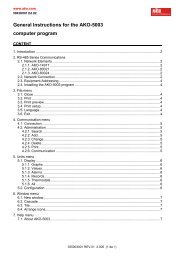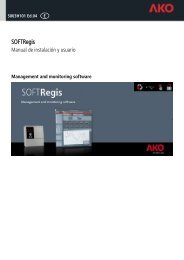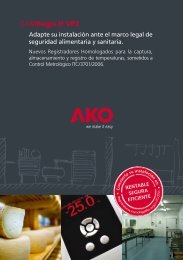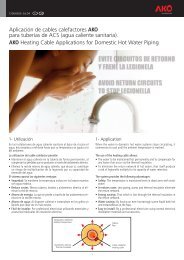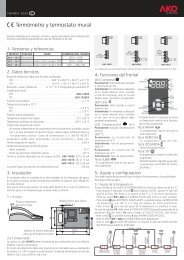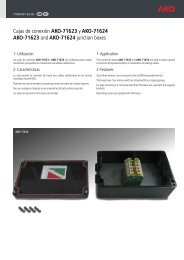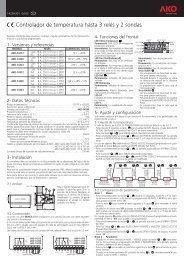Cables calefactores tipo serie con aislamiento de fibra de ... - AKO
Cables calefactores tipo serie con aislamiento de fibra de ... - AKO
Cables calefactores tipo serie con aislamiento de fibra de ... - AKO
You also want an ePaper? Increase the reach of your titles
YUMPU automatically turns print PDFs into web optimized ePapers that Google loves.
HOJA TÉCNICA DE LOS PRODUCTOS SERIE: <strong>AKO</strong>-7132<br />
<strong>Cables</strong> <strong>calefactores</strong> <strong>tipo</strong> <strong>serie</strong> <strong>con</strong><br />
<strong>aislamiento</strong> <strong>de</strong> <strong>fibra</strong> <strong>de</strong> cuarzo<br />
Series tape quartz fiber insulation<br />
heating cables<br />
UTILIZACIÓN<br />
Este <strong>tipo</strong> <strong>de</strong> cables <strong>calefactores</strong> son a<strong>de</strong>cuados para<br />
calentar tuberías y superficies hasta una temperatura<br />
máxima <strong>de</strong> 800°C.<br />
Debido a que el <strong>aislamiento</strong> es <strong>de</strong> tejido <strong>de</strong> <strong>fibra</strong> <strong>de</strong><br />
cuarzo <strong>de</strong>ben instalarse únicamente en lugares completamente<br />
secos, sin riesgo <strong>de</strong> humedad y <strong>con</strong> las protecciones<br />
eléctricas correspondientes.<br />
CARACTERÍSTICAS<br />
Están <strong>con</strong>stituidos por una zona calefactora <strong>con</strong> un <strong>con</strong>ductor<br />
<strong>de</strong> calentamiento espiralado, sobre el cual se<br />
aplica tejido <strong>de</strong> <strong>fibra</strong> <strong>de</strong> cuarzo. En cada extremo <strong>de</strong> la<br />
zona calefactora disponen <strong>de</strong> unos extremos fríos <strong>con</strong>ductores<br />
que permiten efectuar la alimentación <strong>de</strong> los<br />
mismos.<br />
Extremo frío para <strong>con</strong>exión<br />
Connection cold lead<br />
1,5 m<br />
APPLICATION<br />
These type of heating cables are used to heat up pipes<br />
and surfaces until maximum temperature of 800°C.<br />
The cables must be installed only in dry areas, without<br />
danger and with the protection a<strong>de</strong>quates, because their<br />
insulation is quartz fiber.<br />
FEATURES<br />
They <strong>con</strong>sist by a heating length with a heating <strong>con</strong>ductor<br />
spiraled, around it is applied quartz fiber insulation. In<br />
every end it has a cold lead for the <strong>con</strong>nection.<br />
Extremo frío para <strong>con</strong>exión<br />
Connection cold lead<br />
Longitud zona calefactora<br />
Heating length 1,5 m<br />
R<br />
PUBLICACIÓN<br />
7132H100<br />
Edición 04
ESPECIFICACIONES TÉCNICAS / TECHNICAL SPECIFICATIONS<br />
Referencia <strong>de</strong> catálogo / Catalog number: <strong>AKO</strong>-71321 <strong>AKO</strong>-71323 <strong>AKO</strong>-71325<br />
Longitud zona calefactora (m) / Heating zone length (m) 1 3 5<br />
Potencia <strong>de</strong> entrega (+5/-10%) a 230 V (W)<br />
Power output (+5/-10%) at 230 V (W)<br />
170 500 850<br />
Temperatura máxima <strong>de</strong> trabajo (cable <strong>con</strong>ectado)<br />
Maximum workpiece temperature (power on)<br />
800°C<br />
Temperatura máxima <strong>de</strong> exposición (cable <strong>de</strong>s<strong>con</strong>ectado)<br />
Maximum exposure temperature (power off)<br />
900°C<br />
Conductor <strong>de</strong> calentamiento / Heating <strong>con</strong>ductor Ni-Cr<br />
Tipo <strong>de</strong> <strong>aislamiento</strong> / Insulation Fibra <strong>de</strong> cuarzo / Quartz fiber<br />
Diámetro / Diameter 4,6 ± 0,2 mm<br />
Mínimo radio <strong>de</strong> curvatura / Minimum bending radius<br />
10 mm<br />
Extremos fríos para la alimentación:<br />
Connection cold leads<br />
Material / Material<br />
Longitud / Length<br />
Sección / Section<br />
Tipo <strong>de</strong> <strong>aislamiento</strong> / Insulation<br />
Temperatura máxima <strong>de</strong>l <strong>aislamiento</strong> / Max. temperature insulation<br />
INSTRUCCIONES DE INSTALACIÓN<br />
Evitar las aristas cortantes ya que éstas podrían dañar el<br />
cable calefactor.<br />
Empezar la instalación <strong>de</strong>l cable <strong>de</strong>s<strong>de</strong> el extremo <strong>de</strong><br />
<strong>con</strong>exión, enrollándolo sobre la tubería.<br />
Asegurar que la zona calefactora <strong>de</strong>l cable está en <strong>con</strong>tacto<br />
<strong>con</strong> la tubería o equipo.<br />
Evitar que el cable calefactor se toque o cruce, ya que se<br />
crearían puntos o zonas <strong>con</strong> una temperatura <strong>de</strong>masiado<br />
alta que provocaría el <strong>de</strong>terioro <strong>de</strong>l mismo.<br />
DETALLES DE CALORIFUGADO<br />
Proteger el cable <strong>de</strong> posibles daños que puedan ser<br />
causados por la cubierta metálica <strong>de</strong>l <strong>aislamiento</strong>.<br />
ALIMENTACIÓN Y PROTECCIONES<br />
Comprobar que la tensión <strong>de</strong> alimentación coinci<strong>de</strong> <strong>con</strong><br />
la indicada en la etiqueta <strong>de</strong>l cable calefactor.<br />
La instalación ha <strong>de</strong> poseer un interruptor diferencial ya<br />
que el cable calefactor no dispone <strong>de</strong> <strong>con</strong>ductor <strong>de</strong> protección<br />
para <strong>con</strong>ectar a tierra.<br />
La instalación ha <strong>de</strong> cumplir los reglamentos y normas<br />
vigentes <strong>de</strong> la zona.<br />
<strong>AKO</strong> Electromecànica, S.A.L.<br />
Av. Roquetes, 30-38<br />
08812 S. PERE DE RIBES (Barcelona)<br />
Tel. (34) 938 14 27 00<br />
Fax (34) 938 93 40 54<br />
Internet: www.ako.es<br />
e-mail: ako@ako.es<br />
✉ Apartado (P.O. Box), 5<br />
08800 VILANOVA I LA GELTRÚ (Spain)<br />
Ni<br />
1,5 m en cada extremo / 1,5 m for every end<br />
0,75 mm<br />
300°C<br />
2<br />
Fibra <strong>de</strong> vidrio impregnada <strong>con</strong> PTFE / PTFE-glass<br />
INSTALLATION INSTRUCTIONS<br />
Avoid jagged edges because these could damage heating<br />
cable.<br />
Begin the winding around the pipe always at the si<strong>de</strong><br />
where the <strong>con</strong>nection is.<br />
Take care for a good heat transfer.<br />
Avoid that the heating cable crossing or touching,<br />
because this causes a too high temperature which will<br />
damage the heater.<br />
INSULATION DETAILS<br />
Protect the unit against damages from the outsi<strong>de</strong> a<br />
metal plait or a metal jacket.<br />
POWER SUPPLY AND PROTECTIONS<br />
Check that voltage supply it’s acording with the label<br />
heating cable.<br />
Heating cable hasn’t an earth <strong>con</strong>ductor, then the<br />
installation must be protected with a ground leakage<br />
switch.<br />
The installation must be comply with local co<strong>de</strong>s and<br />
practices.<br />
357132100 REV. 03 1.999 D.L.: B-21.909-99 Nos reservamos el <strong>de</strong>recho <strong>de</strong> suministrar materiales que pudieran diferir levemente <strong>de</strong> los <strong>de</strong>scritos en nuestras publicaciones.


